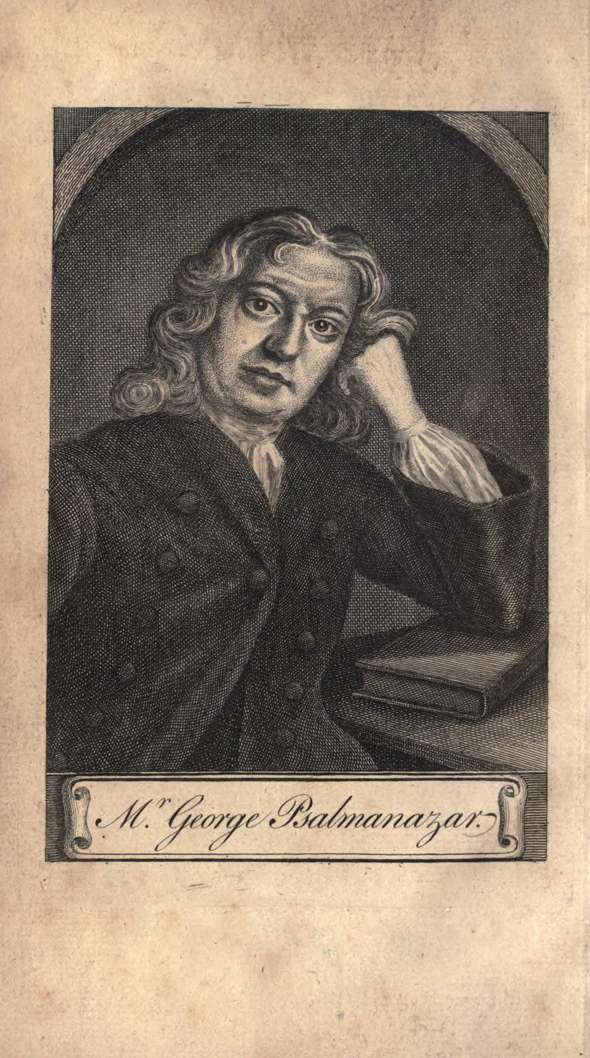
(Probably) French-born George Psalmanazar (1679?-1763) played a hoax on European society in the very early part of the 18th century, posing as a Formosan, or native of Taiwan, which was then controlled by Japan. Since no Formosan had ever visited Europe, with some careful planning he was able to successfully pull of the hoax for some time. Drawing upon descriptions of the Far East and native cultures in America, as well as some clever and unusual invented customs (as well as inventing a language and alphabet, which he was apparently fluent in) he was the toast of Europe for awhile. For his part, Psalmanazar acted exotic, eating spiced raw meat, and pretending to worship the sun. He dramatically converted to Christianity. He published a very popular book called An Historical and Geographical Description of Formosa, an Island subject to the Emperor of Japan, which went through several editions and translations. The book described a truly exotic society, with floating buildings, the division of the year into 20 months, etc.
From the book itself we can see that some were skeptical. For example, in the Second Preface he lists many objections people made to him, like that his historical account "of Formosa differs yet more from what all others have told us than his Geographical; surely then that must be false that has so many witnesses against it." To this he replies ". . . should I be such a Fool to invent an Alphabet, and a Language, purposely to lessen my own Credit?" In other words, the very fact that much of his account contradicts known accounts should be taken as convincing proof of the genuineness of his.
Here is his alphabet:

Gradually skeptics began to challenge his claims more strenuously, and by 1706 he admitted that he was an impostor. He somehow recovered from this - perhaps because his brilliance was so evident - and had a second life as an essayist and scholar, and an apparently sincerely religious man. He even befriended luminaries like Samuel Johnson. As part of his hoax, he had claimed that the Formosans were cannibals, and because of this he is forever immortalized in Jonathan Swift's A Modest Proposal, where Swift had recommended that the English solve their Irish problem by causing the Irish poor to sell their babies for food. He refers to
"the famous Pfalmanaazar, a Native of the Island Formosa, who came, from thence to London above twenty Years ago ; and in Conversation told my Friend, that in his Country when any young Person happened to be put to death, the Executioner sold the Carcase to Persons of Quality as a prime Dainty."
Before he died he wrote a memoir, meant to be printed after death, called Memoirs of ** ** , Commonly Known by the Name of George Psalmanazar; a Reputed Native of Formosa. Amazingly, his real name is still unknown, as the asterisks indicate. Keeping in mind that we are not dealing with a man known for being truthful, his memoirs contain much interesting information, such as his description of how he invented his alphabet. There are some particularly interesting passage for us concerning how he taught himself Hebrew, and tried to make out the correct way of pronouncing it by consulting with Jews.
As you can see, he began to frequent synagogues to hear the ba'alei keriah read the Torah. He had assumed they would be perfect masters of reading Hebrew, but to his surprise he learned that there were broadly speaking two European Jewish pronunciations, the Ashkenazic and Sephardic, which he distinguishes as Northern and Southern European. Furthermore, he recognized the influence of the language of the countries they lived in, "and, as it plainly appeared to me, none of them right." He met some Moroccan Jews whose native language was Arabic, and it seemed to him that their pronunciation might be more pure, but when he actually heard the pronunciation he realized that this was certainly not the case.
This convinced him to stick with the rules as he read them, and to his surprise, he found that Southern (Sephardic) Jews could easily understand him, although he could not understand them so well, on account of their conflation of certain consonants.
Most interestingly, he then says that these Jews "murder it" when they write Hebrew in European letters, and as an example he gives no less than the famous אש דת ("esh dath") of Haham David Nieto, who spelled its title "after his Spanish manner of pronouncing" "Es Dat." Apparently Psalmanazar had read Nieto's famous work against Nehemia Hayun, which he quaintly translates as "A Legal Fire," which sounds like a John Grisham novel. Nevertheless, he says that in time he learned to understand Hebrew as these Jews spoke it.
However, as for Northern (Ashkenazi) Jews, he did not succeed in understanding them (or in them understanding him) and required an interpreter, who was comfortable in both pronunciations. Interestingly, he writes that he found the Ashkenazim "more learned and communicative, as well as more fluent and ready as speaking the sacred tongue."

Here are some earlier pages which I give here because he mentions incidentally how he when learning Hebrew he eschewed "such Bibles as had the servile letters printed in a different kind of character, to distinguish them from the radicals." This Bible refers to the Hutter Bible, which was recommended by the author of the Pri Megadim as an aid for teaching children Hebrew.






